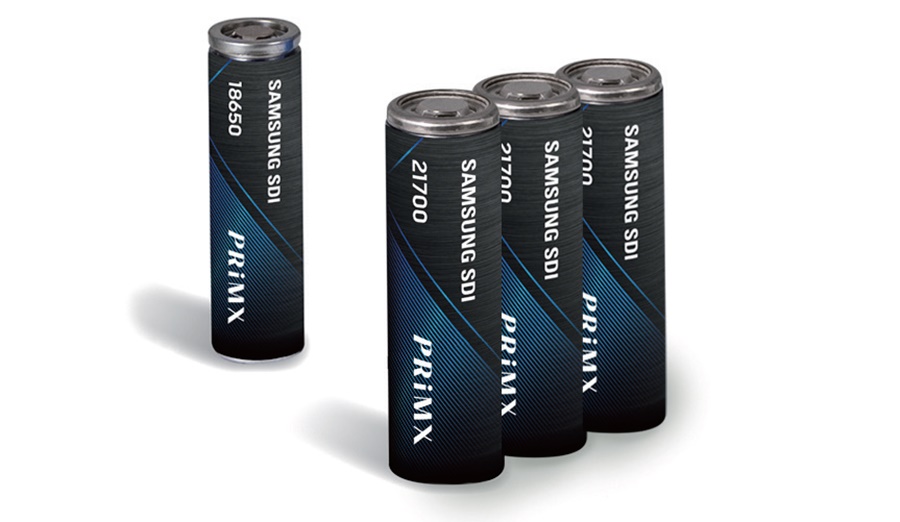Technology & Products
[Battery101] It's All About Basics! Cylindrical Batteries
2024.07.26
|
101[wʌ́nouwʌ́n] means basic knowledge of a topic or collection of introductory materials to a topic. Our Battery 101 series talks about all things battery: the history, technical aspects (basic principles and mechanisms), industrial aspects (IT, electric vehicles, ESS, etc.), and next-generation technologies that SAMSUNG SDI will innovate while opening up its future. Batteries have infinite potentials that exceeds our wildest imagination. Through Batteries 101 series, you will have a chance to see the entire spectrum of the battery's possibilities and to conjure SAMSUNG SDI’s pivotal role in it. |
Small but strong and long-lasting
Cylindrical batteries are like a mighty mite: they are tiny but strong and last so long. They are the first commercialized battery after the introduction of lithium-ion batteries in 1991 and deemed as the 18650 battery because their size is 18 mm in diameter and 65 mm in height. Once this size (diameter: 18mm, height: 65mm) was set and fully commercialized, cylindrical batteries fueled the development of battery manufacturing technologies. Cylindrical batteries have shown higher productivity compared to prismatic or pouch batteries. Due to its long history, the cylindrical battery industry poses a barrier for newcomers without know-hows accumulated over a long period of time.

[Cylindrical batteries of SAMSUNG SDI]
High capacity and high power is the key characteristics of cylindrical batteries. This is because cylindrical batteries are structured in the shape of a jelly roll, which is its building block that houses cathode, anode, and separator. These cylinder-shaped batteries have a high energy density as they maximize spatial efficiency while its low internal resistance produces a high output.
Cathode materials for cylindrical batteries are high-nickel chemistries that contain over 60% nickel. In general, lithium nickel cobalt aluminum oxide (NCA) and lithium nickel cobalt manganese oxide (NCM) are used. Such high nickel content benefits capacity and output aspects of a battery, but it may lead to a lower level of safety at the same time. The risk of ignition in cylindrical batteries, however, is rather on a lower side since they dissipate heat evenly thanks to their round shape and supplementary devices that ensure safety.
A pressure, temperature and current switch (PTC), a current interrupt device (CID), and vents are some examples of safety devices. PTC blocks the current in the event of overcurrent and resistance increase. Meanwhile, CID blocks the current when the pressure increases inside the battery as gas forms. Lastly, the vent releases gas from the inside to prevent explosion.
Applications that herald the revival of cylindrical batteries
The development of batteries is closely related to their applications. That is, it is all about what consumers need and want.
Cylindrical batteries are easier to manufacture in mass production and have price competitiveness. Despite such advantages, the size of the cylindrical battery market decreased because of its relatively bigger volume with the emergence of thin and light IT devices. There were times when cylindrical batteries were on the brink of extinction in the market.
Fortunately, cylindrical batteries regained their old glory when a new market for them emerged: cordless power tools. Handling power tools was not easy as they were bulky and heavy, and needed to be connected to power, so using such power equipment was considered a job for experts only. However, when the market saw cordless power tools, it led to the popularization of a do-it-yourself culture, where people build furniture and design their houses on their own to their liking.
It is batteries that led the era of cordless power tools. Power tools are devices that require high levels of outputs and safety standards as they are used to drill holes through concrete, or cut wood. Accordingly, these power tools need batteries with long life and high capacity.
That’s how the growth of the cordless power tool market revived the cylindrical battery market. Today, cylindrical batteries are also commonly used in the micromobility market that includes e-bikes, as well as in the EV market. According to a finding by SNE Research, a market research company, it is expected that more than 15 billion cylindrical batteries will be sold in 2030, from 9.8 billion units in 2022.

[Sales of small and cylindrical batteries]
The EV market size is enormous, which doesn't even compare to that of laptops or power tools, the old-time primary market of cylindrical batteries. This is because thousands of batteries are built into a single EV, compared to gadgets carrying 10 or fewer batteries.
SAMSUNG SDI makes 18650 cylindrical batteries (diameter: 18 mm, height: 65 mm) and 21700 cylindrical batteries (diameter: 21 mm, height: 70 mm) geared with enhanced capacity by up to 50% as well. We are also developing mid- to large-sized cylindrical batteries with 46 mm diameter. Through these efforts, we are expanding our portfolio in diverse applications encompassing power tools, e-bikes, and EVs.
